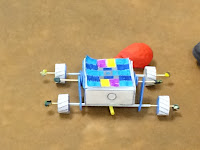Task: Build a Balloon Powered Nanorover
Students were given design instructions and were to follow the directions in order to build a Nanorover that could successfully move as if to recreate the movement of a rover on Mars. The instructions were numerous and very specific.
Grade 6 Students working together in groups of 2
Currently students are studying Sky Science. The task was an extension activity designed to increase curiosity in discovering what the Mars surface might be like and how we have gained the information we have so far and realize the time and energy required to create the different forms of technology.
Curriculum Link:
Specific Learner Expectations
Students will show growth in acquiring and applying the following traits:
• confidence in personal ability to learn and develop problem-solving skills
• perseverance in the search for understandings and for solutions to problems
• a willingness to work with others in shared activities and in sharing of experiences
• appreciation of the benefits gained from shared effort and cooperation
• a sense of personal and shared responsibility for actions taken
Specific Learner Objective:
Identify technologies and procedures by
which knowledge, about planets and other
objects in the night sky, has been gathered
Students were provided access to all necessary materials however very little assistance was given. Students were guided to figure out what instructions were saying.
Observations:
- Some students struggled to complete the task due to errors made along the way. Some of the errors were due to skipping steps in the building process. I found that some students could visualize the big picture and attempted to use their vision to create their rovers however in doing so missed some steps that helped to create a stable rover.
- Some students appreciate the step by step instructions whereas those students who prefer trial and error struggled to follow the directions.
- Students that were very successful were those that worked well with their partners and discussed the steps and worked together the entire time.
- Some students built their rovers however they didn't move much to their disappointment. The follow up was then to determine "why" and how could they fix or modify their rover in order to be successful.
As a follow up activity, a discussion was had surrounding the successfully built rovers and determining how NASA would go about testing their design. What would be some of the obstacles to sending a rover to Mars. Finally looking at the speed at which the rover moves and relating that back to the reality of the distance between Earth and Mars and how we would ultimately communicate with a rover. This in turn did lead to a discussion of the future mission of sending humans to Mars.




No comments:
Post a Comment